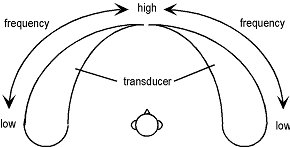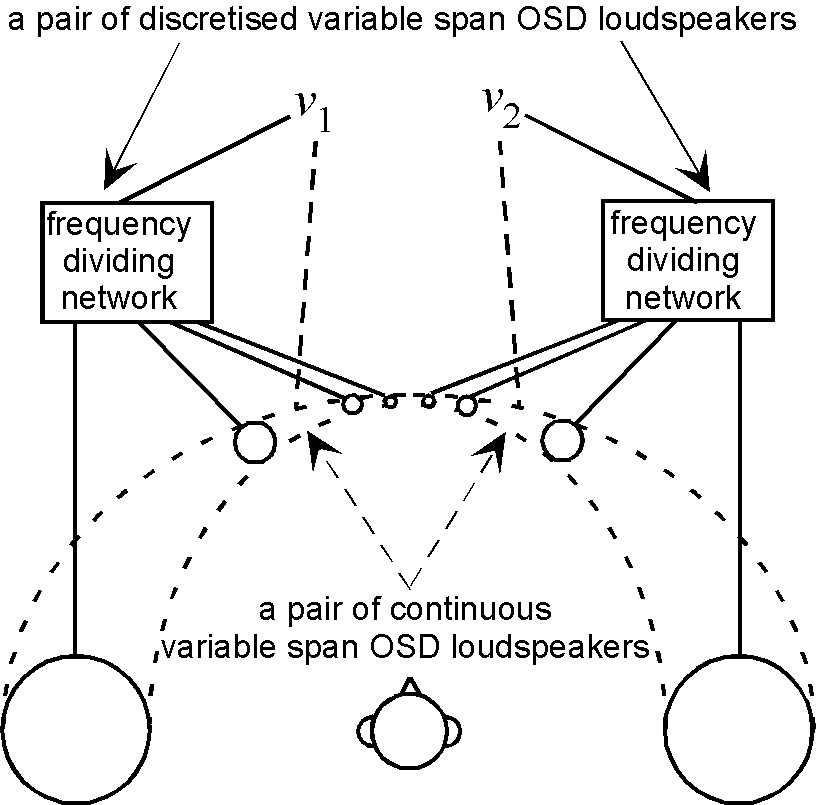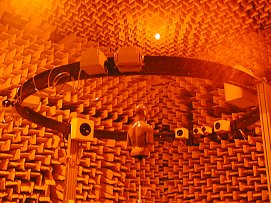|
When binaural sound signals are presented with loudspeakers, the system inversion involved gives rise to a number of problems.
The amplification required by the system inversion and cancellation of sound at listener's ears results in loss of dynamic range,
low signal to noise ratio, more severe non-linear distortion and fatigue of transducers. Errors contained in the plant, such as individual
differences in head related transfer functions or misalignment of loudspeakers and the listener's head, results in deterioration of control
performance and colouration of sound. Regularisation is often used to design practical filters but this is a process by which a small error is
intentionally introduced and this results in poor control performance. Also the loudspeaker pair radiates a much larger level of sound having a
peaky frequency response in many directions, compared to the direction of the ears where the interference field leaves a small level of flat response sound.
This results in severe reflections which cause colouration of sound and degrade control performance.
Many of these problems are created or emphasised by the geometrical arrangement of the transducers and a listener's ears.
Principle and aspects

These problems for such systems are investigated and this has resulted in the proposal of a new system concept, the Optimal Source Distribution.
The "OSD" system overcomes these fundamental problems by means of a pair of conceptual monopole transducers whose position varies continuously as a function of frequency.
The significance is that many of the problems described earlier associated with the multi-channel system inversion disappear with this principle and others are much mitigated.
Since the sound from each transducers is always helping (not cancelling) each other at listener's ears, there is no dynamic range loss compared to the case without system inversion.
This means the system has good signal to noise ratio and advantage over distortion or fatigue of transducers.

The inverse filters have flat frequency response so there is little colouration due to different HRTFs nor at any location in the listening room.
Therefore, monaural localisation cues are preserved hence the elevation of sound (height and rear) is reproduced anywhere in the listening room, even from stereo and surround recordings.
The sound radiation by the transducer pair has a constant lobe independent of frequency as opposed to conventional crosstalk cancellation generates frequency dependent lobe.
This enables presenting left ear signal and right ear signal to multiple listeners at constant intervals typically of seating intervals.
The radiation in all directions is always smaller than those at the receiver directions, which is also smaller than the sound radiation by a single monopole transducer producing the same sound level at the ears.
Therefore, the system is also robust to reflections in a reverberant environment.
Transducers

Several examples of practical solutions that can realise a variable transducer position are also described. One of them is the discretisation
(discretising a continuously variable position) which results in multiple pairs of transducers for each frequency range with corresponding transducer positions.
It enables the use of currently available transducers yet expands the operational frequency region to be used with only a little decrease in performance.
All passive, active, and digital cross-over filters can be used for the discrete OSD system to distribute each frequency component into corresponding driver pair
so that the system requires only 2 channels of independent signals to create a full 3D spatial virtual sound environment.
|
|
3 Channel Optimum Source Distribution
Binaural reproduction over loudspeaker requires system inversion which is
often referred to as cross-talk cancellation. Such process is the major factor to degrade the quality of 3D sound reproduction but the Optimal Source
Distribution (OSD) provides simple and effective signal processing and loudspeaker design principle which enables lossless crosstalk cancellation
process. The OSD takes advantage of its physical property which ensures that in-phase and out-of-phase components of the binaural reproduction process are
balanced. Hence the bulk of the crosstalk cancellation is achieved by its loudspeaker design principle and the related natural interference in the sound
field. Inverse filters of the OSD have a unique property where only the simple phase change is required in essence for the perfect crosstalk cancellation.
Therefore, each filter has flat frequency response that lead to advantages in many respects. The advantage of the OSD is further enhanced by separating
in-phase and out-of-phase components through an alternative system design. |

OPSODIS home theatre system |
|
Extension to three channel case
As discussed above, the two-channel OSD essentially uses the
frequency-direction relationship where the two singular values, representing
the in-phase and out-of-phase components of the binaural reproduction
process, are balanced in order to overcome the fundamental problems of
conventional binaural reproduction over loudspeakers. however, a system
which aims to improve this further is proposed in what fallows. For
convenience, we refer to it as the "three channel OSD" system in contrast to
the earlier OSD that will henceforth be referred as the "two channel OSD".
|

